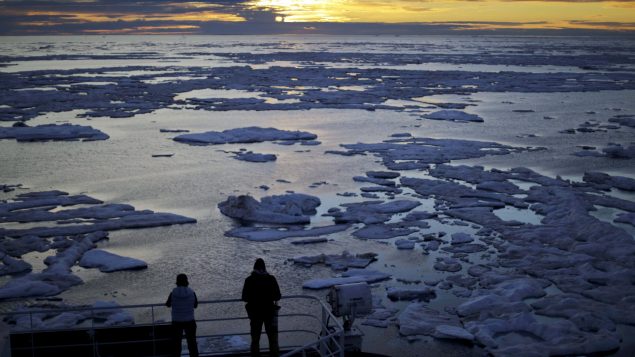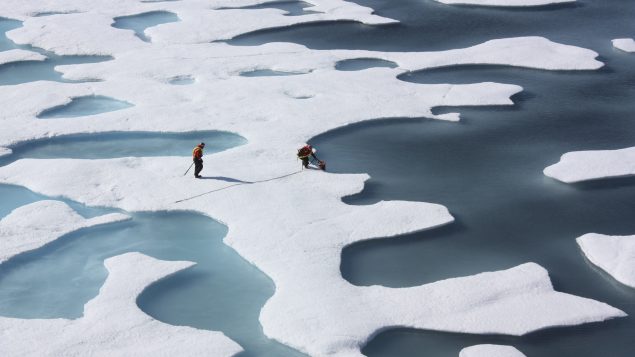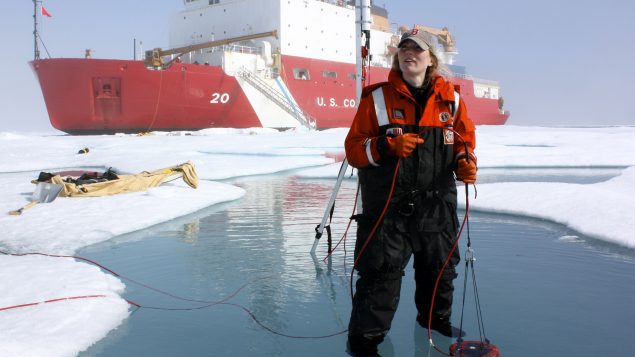The Arctic could be completely ice-free in summers by 2035, according to a new study that compared present-day conditions with those about 130,000 years ago.
The study published this week in the journal Nature Climate Change, looked at the last interglacial, a warmer period 130,000–116,000 years ago, as a potential analogue for future climate change.
During this period, the nearly 24-hour summertime sunshine at high northern latitudes drove Arctic land summer temperatures 4–5 C higher than in the pre-industrial era.
These higher temperatures had puzzled scientists for decades, said lead author Maria Vittoria Guarino, Earth System Modeller at British Antarctic Survey (BAS).
A window into the future

FILE – In this July 21, 2017 file photo, researchers look out from the Finnish icebreaker MSV Nordica as the sun sets over sea ice floating on the Victoria Strait along the Northwest Passage in the Canadian Arctic Archipelago. (David Goldman/AP Photo/ File)
Unravelling this mystery was technically and scientifically challenging, she said.
“For the first time, we can begin to see how the Arctic became sea ice-free during the last interglacial,” Guarino said in a statement.
During spring and early summer, shallow pools of water form on the surface of Arctic sea-ice.
These so-called melt ponds are important for how much sunlight is absorbed by the ice and how much is reflected back into space, scientists say.
The team of international researchers used the UK Met Office’s Hadley Centre climate model to look at Arctic sea ice during the last interglacial.
The team concluded that the impact of intense springtime sunshine created many melt ponds, which played a crucial role in sea-ice melt.

The crew of the U.S. Coast Guard Cutter Healy, in the midst of their ICESCAPE mission, retrieves supplies for some mid-mission fixes dropped by parachute from a C-130 in the Arctic Ocean in this July 12, 2011 NASA handout photo obtained by Reuters June 11, 2011.
(Kathryn Hansen/REUTERS/NASA)
Moreover, a simulation of the future using the same model indicated that the Arctic may become sea ice-free by 2035.
“The advances made in climate modelling mean that we can create a more accurate simulation of the Earth’s past climate, which, in turn gives us greater confidence in model predictions for the future,” Guarino said.
Louise Sime, a joint lead author at BAS, said by understanding what happened during Earth’s last warm period scientists are in a better position to understand what will happen in the future.
“We know the Arctic is undergoing significant changes as our planet warms,” Sime said. “The prospect of loss of sea-ice by 2035 should really be focussing all our minds on achieving a low-carbon world as soon as humanly feasible.”
Influencing polar climate and ecosystems

ICESCAPE scientist Karen Frey takes optical measurements in a melt pond in the Arctic Ocean, with the U.S. Coast Guard Cutter Healy on the background in this undated handout photo obtained by Reuters June 11, 2012. (Kathryn Hansen/REUTERS/NASA)
According to scientists at NASA Earth Observatory, sea ice has a profound influence on the polar environment, influencing ocean circulation, weather, as well as regional and global climate.
The white surface of the sea ice acts like a giant mirror that reflects far more sunlight back to space than darker ocean water does. Once sea ice begins to melt, it often triggers a self-reinforcing cycle. As more ice melts, exposing more dark water, the water absorbs more sunlight. The sun-warmed water then melts more ice.
Over several years, this positive feedback cycle can influence global climate, according to NASA Earth Observatory.
Sea ice also plays a fundamental role in polar ecosystems and supports a variety of life forms from bacteria and phytoplankton to seals and polar bears.
And sea ice is essential for many northern and Indigenous communities who’ve used it for millennia to hunt, fish and travel.
Record sea ice retreat in July
The new study comes amid reports that the Arctic sea ice extent reached a record low in July, shrinking to levels not seen since satellite observation of the region’s ice cover began in the late 1970s.
According to an international team of researchers drifting in the Arctic aboard the German research icebreaker, Polarstern, the sea ice retreat this year has been especially pronounced off the Siberian coast, leading to a virtually ice-free Northeast Passage by mid-July along nearly all of Russia’s Arctic coastline from the Bering Sea in the east to the Barents Sea in the west.
According to the U.S.-based National Snow and Ice Data Center (NSIDC), sea ice extent averaged for July 2020 was 7.28 million square kilometers. This was 2.19 million square kilometers below the 1981 to 2010 July average and 310,000 square kilometers below the previous record low mark for July set in 2019.
The record low ice extent in July followed a scorching month of June when a cell of warm air produced extremely high temperatures in Siberia that seriously impacted the sea ice cover in the Russian Arctic, according to the Multidisciplinary drifting Observatory for the Study of Arctic Climate, or MOSAiC for short.







For reasons beyond our control, and for an undetermined period of time, our comment section is now closed. However, our social networks remain open to your contributions.